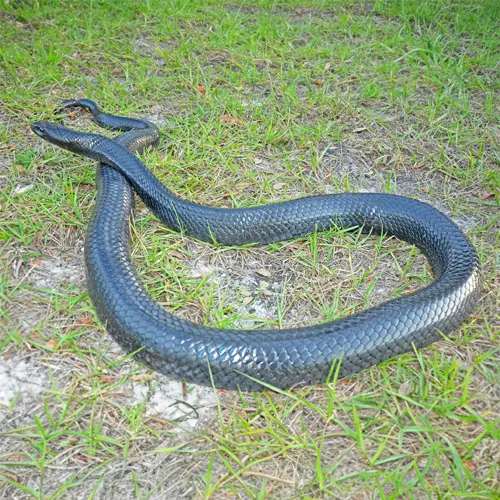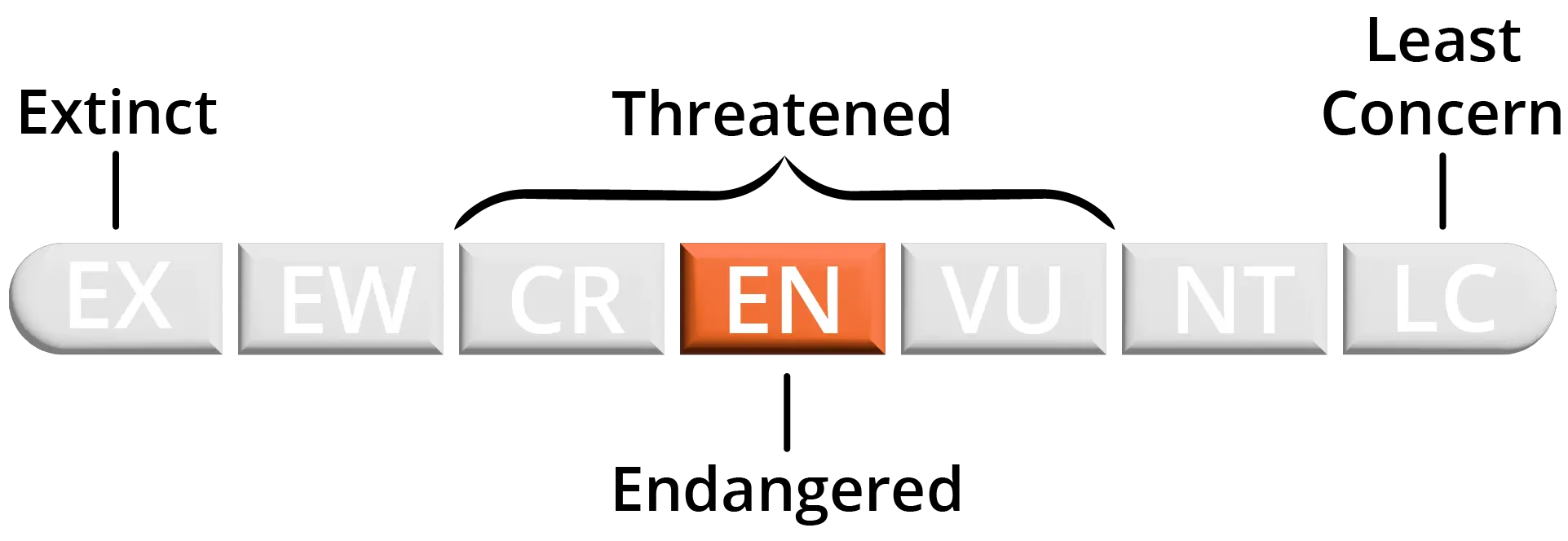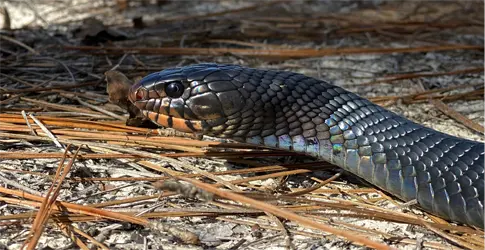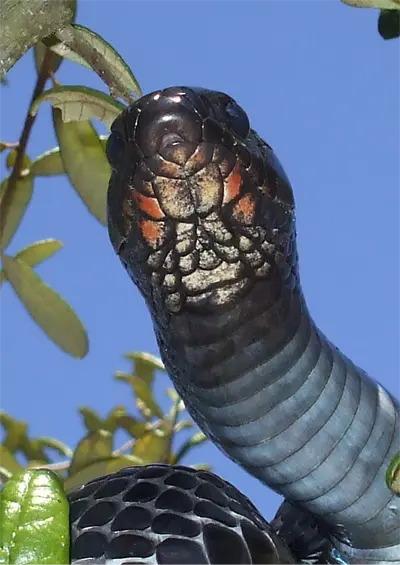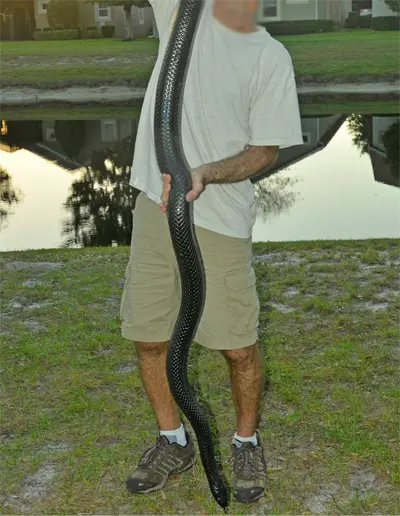Eastern Indigo Snake
- Scientific Name
- Drymarchon couperi
- Also Known As
- Blue Indigo Snake
- Range
- Most of Florida
- Diet
- Small Mammals, Birds, Reptiles, Insects
- Life Expectancy
- Over 15 Years
Quick Links
Eastern Indigo Snakes in Central Florida
The eastern indigo snake (Drymarchon couperi) is a large, nonvenomous colubrid snake found in the southeastern United States, with a significant population in central Florida. As opportunistic apex predators, eastern indigo snakes play an important role in these ecosystems.
This guide provides identification tips, biology facts, and conservation efforts for the eastern indigo snake in central Florida.
Appearance and Identification
Eastern indigo snakes can be identified by their glossy, blue-black coloration and large size
Photo 261206732 © Brandon, CC BY-NC
Adult Eastern Indigo Snakes
Juvenile Eastern Indigo Snakes
The eastern indigo snake is the longest native snake in North America. Its blue-black sheen and orange throat markings distinguish it from other dark rat snakes which have a dull gray hue with lighter flecking.
Maturation Rate
Young eastern indigo snakes grow quickly, shedding their skin frequently as juveniles to accommodate their rapid growth. They gain about 1 foot in length within their first year. Eastern indigos reach adult size after 2-3 years when they acquire reproductive maturity.
Habits and Behavior
Eastern indigo snakes are active during the day (diurnal) in warmer months but become more nocturnal and secretive during winter. They utilize a variety of habitats including scrub, sandhills, agricultural fields, and human-altered areas.
These snakes are adept climbers and will ascend trees or other sheltered sites to forage for bird nests. However, they spend most of the time hunting small mammals, frogs, lizards, snakes, and invertebrates on the ground. Home ranges can exceed 300 acres but concentrate around nesting and den sites.
Eastern indigo snakes breed from November to April and females lay 5-12 eggs as early as April through June. Eggs incubate for 60-120 days before hatching from July to October. Hatchlings are independent immediately.
Reproduction and Lifespan
Eastern indigo snakes reach reproductive maturity at 2-3 years old. Females breed every 1-2 years while males may breed yearly. Courtship involves ritualized mating combat where males spar heads.
Females lay 5-12 eggs in burrows or stump holes and the eggs incubate from 60-120 days before hatching. Mother snakes provide no parental care. Hatchlings are about 1 foot long and grow rapidly, shedding often as juveniles. Lifespan in the wild can exceed 15 years.
Ideal Habitat and Range
The eastern indigo snake inhabits a range of habitats in Florida and Georgia, concentrated in peninsular Florida. Central Florida provides optimal habitat due to its mosaic of upland ecosystems including pine flatwoods, scrubby flatwoods, longleaf pine-xeric oak sandhills, and agricultural areas.
These habitats share sandy, well-drained soils and a mix of open sandy areas and dense underbrush. The diverse habitats provide the full range of eastern indigo snake needs – heavy brush and burrows for cover and nesting, and open areas for thermoregulation and hunting. The mild winters and hot, humid summers also suit these cold-intolerant snakes.
However, habitat loss to development has reduced and fragmented the snake’s natural range. Conservation of intact ecosystems is vital for the indigo snake’s survival.
Diet and Feeding
Eastern indigo snakes are opportunistic generalist predators that consume a wide variety of small animals based on availability:
- Small mammals – rats, mice, squirrels, moles, rabbits
- Birds – nestlings and eggs
- Reptiles – snakes, lizards, frogs, salamanders
- Arthropods – insects, arachnids
- Gastropods
They kill prey through constriction and eat them head first. Adult snakes may eat prey up to one-third their own size. Food availability impacts growth rates – snakes in resource-poor areas mature at smaller adult sizes. These snakes mainly hunt during the day and use chemical cues to locate prey on the move.
Hunting strategy involves ambush from cover, though indigos will actively pursue prey over longer distances. Ideal habitat provides plentiful rodents, reptiles, and amphibians to sustain eastern indigo snakes throughout the year.
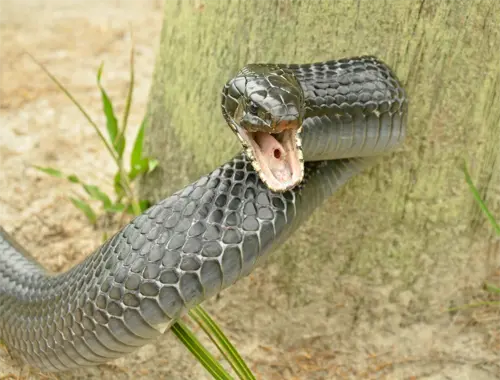
Photo 220175506 © John Serrao, CC BY-NC

Common Health Risks
Eastern indigo snakes are nonvenomous, so their bite presents limited health risks:
- Minor puncture wounds from small, rear-facing teeth. Wounds should be thoroughly cleaned to avoid infection.
- Potential to transmit salmonella bacteria from reptile saliva. Proper hand washing minimizes this risk.
- No envenomation injuries. Eastern indigo snakes kill prey through constriction only.
- Defensive bites are rare and mainly occur due to mistaken identity or improper handling. Healthy wild indigo snakes generally avoid confrontation.
- While not medically significant, their large size enables eastern indigo snakes to inflict painful defensive bites that should be treated as wounds.
Overall, eastern indigo snakes pose minimal health hazards if proper distance is given. Their role as vital apex predators outweighs the negligible risks their presence represents. With proper identification and space, eastern indigo snakes and humans can safely coexist.
Common Threats to Eastern Indigo Snakes
Although a formidable predator in its own right, the eastern indigo snake faces an array of threats that have contributed to population declines:
- Habitat destruction – Development, agriculture, and pine plantations have destroyed and fragmented the snake’s native ecosystem habitats like longleaf pine sandhills. This disrupts their hunting ranges and ability to find mates.
- Vehicle collisions – Eastern indigo snakes often get struck crossing roads between habitat fragments. Their dark coloration camouflages them on roads.
- Collection by humans – These snakes are prized in the pet trade for their size and color, leading to many being illegally captured from the wild despite legal protections.
- Confusion with venomous snakes – The eastern indigo’s glossy black color leads to cases of mistaken identity where they are mistaken for cottonmouths or rattlesnakes and killed out of fear.
- Pollution – Air and water pollution degrades habitat quality. They are also susceptible to upper respiratory infections from pollution.
- Climate change – Rising temperatures may exceed snakes’ heat tolerance thresholds in the warmer parts of their range.
Targeted conservation initiatives are needed to reverse these threats and preserve vital habitat corridors across central Florida’s mosaic of pine flatwoods, scrub, wetlands, and human-altered areas. The eastern indigo snake’s future depends on successful human coexistence.
Photo 110298152 © bobzappalorti, CC BY-NC
Photo 220175506 © John Serrao, CC BY-NC Modified to Protect Identity
Conserving the Eastern Indigo Snake
Several initiatives aim to conserve eastern indigo snakes in central Florida:
- Public education programs teach citizens the benefits of indigo snakes in controlling pests naturally. This reduces persecution.
- Wildlife underpasses, culverts, and signage help snakes cross roads safely to access habitat.
- Tracking and monitoring provides data on indigo snake populations and movements.
- Habitat restoration improves quality and connectivity of native ecosystems. Controlled burning maintains optimal sandhill structure.
- Development incentives promote snake-friendly practices like providing buffer zones around snake habitat during construction projects.
- Legal protection makes it illegal to harm, harass or collect eastern indigo snakes. Fines can be imposed.
The goal is to maintain habitat corridors and connectivity so indigo snake populations can thrive. Continued efforts are needed to conserve ample intact range across central Florida landscapes.
Florida Water Rats in Central Florida – Conclusion
As Florida’s largest and most dangerous native venomous snake, eastern diamondbacks demand caution and respect from residents and visitors to the region. Their cryptic habits, potent hemotoxic venom, large size, and abundance in central Florida’s wilderness areas make accidental encounters a risk.
However, through education and preventative yard maintenance, problems with eastern diamondbacks can often be avoided. If bitten, immediately seek emergency medical care for antivenom administration and rapid treatment.

